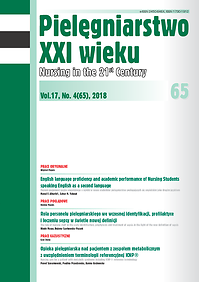Stress coping styles and occupational burnout syndrome of nurses employed in intensive care units
DOI:
https://doi.org/10.2478/pielxxiw-2018-0029Keywords:
nurse, intensive therapy, stress, burnoutAbstract
STRESS COPING STYLES AND OCCUPATIONAL BURNOUT SYNDROME OF NURSES EMPLOYED IN INTENSIVE CARE UNITS
Aim. The aim of the study is to evaluate a relationship between demographic and work-related factors and a work stress coping style as well as a relationship between a work stress coping style and symptoms of occupational syndrome.
Material and methods. Material was collected from 50 nurses employed in intensive care units of clinical hospitals of the Medical University of Lodz. The study was conducted as a diagnostic survey using the following survey techniques: author’s questionnaire and the Coping Inventory for Stressful Situations (CISS).
Results. The study group demonstrated the highest mean value for the task-oriented coping style and the lowest mean value – for the avoidance-oriented coping style. Age, education level and subjective determination of the degree of work-related stress affect the value of the task-oriented coping style. The emotion-oriented stress style is accompanied by heart palpitations and avoidance of physical activity. The value of the avoidance-oriented coping sub-style, i.e. distraction, depends on atmosphere at workplace, heart palpitations and sleep problems. The value of the avoidance-oriented coping sub style, i.e. social diversion, is contributed by marital status, fertility and work organization.
Conclusions. Nurses working in intensive care units prefer the task-oriented coping style. Work stress coping style is related to demographic factors and perception of work environment. An unadaptive style of coping with work-related stress is accompanied by symptoms of somatic occupational burnout syndrome.
References
1. Grochowska A, Bodys-Cupak I, Korus M. Sposoby radzenia sobie z trudnościami przez pielęgniarki pracujące na oddziałach pediatrycznych. Pielęg Pol. 2017;1(63): 97-104.
2. Wzorek A. Porównanie przyczyn stresu wśród pielęgniarek pracujących na oddziałach o różnej specyfice. Stud Med. 2008;11:33-37.
3. Kotarba A, Borowiak E. Pielęgniarka w Służbie Więziennej a radzenie sobie ze stresem zawodowym. Probl Piel. 2016;24(3-4):188-192.
4. Marcysiak M, Dąbrowska O, Marcysiak M. Wypalenie zawodowe a radzenie sobie ze stresem pielęgniarek. Probl Piel. 2014; 22(3): 312-318.
5. Walkiewicz M, Sowińska K, Tartas M. Wypalenie zawodowe wśród personelu medycznego – przegląd literatury. Prz Lek. 2014;71(5):263-269.
6. Li X, Guan L, Chang H, Zhang B. Core self-evaluation and burnout among Nurses: the mediating role of coping styles. PLoS One. 2014;9(12):e115799.Cytowany dn. 22.05.2018r. Adres: https://www.ncbi.nlm.nih.gov/pubmed/25541990.
7. Strelau J, Joworowska A, Wrześniewski K, Szczepaniak P. Kwestionariusz radzenia sobie w sytuacjach stresowych CISS. Podręcznik do polskiej normalizacji. Warszawa: Pracownia Testów Psychologicznych Polskiego Towarzystwa Psychologicznego; 2009.
8. Kupcewicz E. Jakość życia pielęgniarek a strategie radzenia sobie ze stresem doświadczanym w środowisku pracy. Med Og Nauk Zdr. 2017; 23(1): 62-67.
9. Kwiecień-Jaguś K, Wujtewicz M, Mędrzycka-Dąbrowska W, Gaworska-Krzemińska A. Obciążenie pracą a satysfakcja zawodowa pielęgniarek oddziałów intensywnej terapii w placówkach ochrony zdrowia noszących miano Szpitali Magnesów (Magnet Hospital). Probl Piel. 2012;20(4):529-534.
10. Głowacka M, Orzoł A, Soleta A. Obciążenia zawodowe w praktyce pielęgniarek anestezjologicznych i intensywnej opieki. J Pub Health Nurs Med Res. 2012;(4):5-13.
11. Zdziebło K, Zboina B, Stępień R, Mędrykowska A. Stres zawodowy jako czynnik determinujący jakość życia w opinii pielęgniarek. Pol J of Health and Fitness. 2015;(1):57-71. Cytowany dn. 22.04.2018r. Adres:www.pjhf.wsbip.edu.pl/images/artykuly/4.pdf.
12. Miler-Zawodniak A. Teorie potrzeb jako współczesne teorie motywacji. Obronność - Zeszyty Naukowe Wydziału Zarządzania i Dowodzenia Akademii Obrony Narodowej. 2012; (4):101-116.
13. Li L, et al. Moderating effects of coping on work stress and job performance for nurses in tertiary hospitals: a cross-sectional survey in China. BMC Health Serv Res. 2017; 17(1):401. Cytowany dn. 22.05.2018r. Adres: https://www.ncbi.nlm.nih.gov/pubmed/28606180.
14. Stępień M, Szmigiel M. Stres personelu pielęgniarskiego związany z pracą na oddziałach pediatrycznych. Pielęg Pol. 2017;(63):62-98.
15. Lee HF, Kuo CC, Chien TW, Wang YR. A Meta-Analysis of the Effects of Coping Strategies on Reducing Nurse Burnout. Appl Nurs Res. 2016; 31:100-10. Cytowany dn. 22.05.2018r. Adres: https://www.ncbi.nlm.nih.gov/pubmed/27397826.
16. Nowak-Starz G, Kozak B, Zdziebło K. Wpływ stresu związanego z pracą zawodową na występowanie zespołu wypalenia zawodowego u pielęgniarek pracujących w oddziałach zabiegowych i zachowawczych. Stud Med. 2013; 29(1): 15-21.
Published
Issue
Section
License
Copyright (c) 2018 Authors

This work is licensed under a Creative Commons Attribution-NonCommercial-NoDerivatives 3.0 Unported License.




